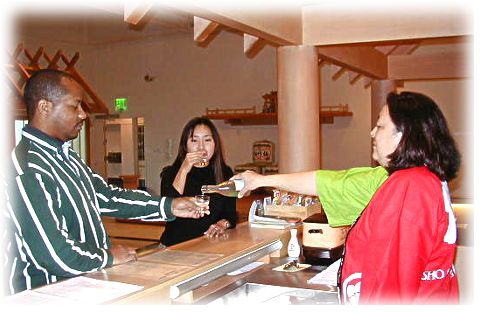
California Coastal Climate Superb for Sake
Liz Garone
One of the most common misconceptions about Japanese wine, AKA sake, is that it must be served hot, according to Mika Tsuchiiwa, tasting room manager at Takara Sake USA in Berkeley. "Sake can be cold, hot, warm, iced, however you like it," said Tsuchiiwa. "We try to educate people here in the tasting room and museum."
The Takara sake factory has been in Berkeley since 1982 when Takara's parent company in Kyoto, Japan, bought the Numano Sake Company at the same location. From the outside, the Takara buildings have few distinguishing features: a swatch of light blue rectangular boxes covering a square block.
But, once inside the tasting room, the environment turns serene, transporting visitors far from bustling Fourth Street and the hustle of University Avenue and Highway 80, only a few minutes away, to the Japanese countryside. Classical flute music plays gently in the background. The walls are smoothed Douglas Fir; gray-blue boulder-like structures stand out against a glass tiled floor, giving the room the appearance of unending rice paddies. Next to the tasting room is a museum that details the history of sake-making through easy-to-follow diagrams and actual examples of original sake-making equipment. Sake production is believed to have started during the Nara Era (710-94 BC).
Temperature is not the only misconception Americans have about the national drink of Japan, according to Tsuchiiwa. There are plenty of others, including the idea that sake, like wine, improves with age. "Fresh is always better," said Tsuchiiwa. "Consume it as soon as possible."
This is something anyone living in the Bay Area has ample opportunity to do. Of the seven (soon to be six) sake producers in the United States, four are in Northern California: Takara in Berkeley, Hakusan in Napa, Gekkeikan in Folsom and Ozeki in Hollister. Los Angeles has one, American Pacific Rim, and Forest Grove, Oregon, has another, the Japan American Beverage Company. The only sake producer not located in a coastal state is Hakushika in Colorado, but it will close March 31 due to the economic downturn in Japan. While its business in the U.S. has been growing by 10 to 15 percent each year, its parent company can't afford to keep the U.S. factory open.
The price range for domestic (U.S.) sake is much narrower than that of grape wine: between $5 and $7 for 750 ml bottles, or $9-10 for 1.5 liter bottles, according to Tsuchiiwa. American sake consumers won't pay more, so Takara has to keep its prices low, she said. But premium sakes imported from Japan can cost as much as $200.
Is it coincidence that Northern California has the wealth of sake producers? "Not at all," said Tsuchiiwa. "It is the best location because of the climate." One of the benefits of being near the fog-shrouded bay is that temperature extremes are a rarity. In Japan, sake producers must pay exorbitant refrigeration costs during humid, hot summers. Some factories are even forced to shut down completely during the summer months. But, not in the Bay Area, where sake production is a year-round activity.
The rice for Takara sake comes from the Sacramento Valley; the water, from the Sierra Nevada.
At Hakusan in Napa, the rice is also trucked in from Sacramento. Much like the wineries that grow their own grapes, Hakusan grows its own rice, according to tasting room manager Lesley Clark. "That way, there are no surprises," she said.
Surprises come only when visitors put the many varieties of sake to their tongues. From amai (sweet) to karai (dry), different brands and flavors of sake can be worlds away from the water-like substance poured at many Bay Area Japanese restaurants. For example, Nigori-zake is unfiltered sake and looks like water infused with milk. It has a lightly sweet, chalky taste to it. Ume-shu is not really a sake at all but rather plum wine; it is both sweet and tangy.
Sake has the highest alcohol content of any fermented drink on the market. In its natural, undiluted state, sake is 20 percent alcohol, which compares to 9-12 percent for most wines and 3-5 percent for beer. By the time most sake gets to the table or on the store shelves in the United States, it has around 16 percent alcohol.
"So, don't let the sweetness (of certain sakes) fool you," said Clark.
Sake tasting: Both Hakusan and Takara offer sake tasting. Takara is open from 12-6pm everyday. There is no charge for tasting five sakes. For more information, call (510)540-8250. Hakusan is open from 10am-5pm. The cost is $1 for four sakes. For more information, call (707)258-6160.
